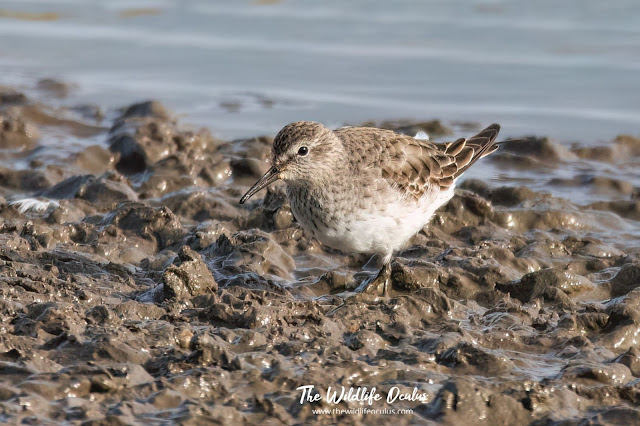A nice specimen of American Rump
I visited WWT Slimbridge today and was overjoyed to see for the first time ever - the White-Rumped Sandpiper (Calidris fusicollis) that has been on the reserve since Tuesday when it was first spotted by an eagle eyed birder.
This species is classed as a scarce visitor to the UK by the BTO and is actually an American species of wader.
White-Rumped Sandpipers breed in the high arctic in Northern Canada in the summer months. These sandpipers have a truly epic migration journey, having one of the longest of any North American bird. They winter as faraway as South America and some birds are known to have flown some 2500 miles without resting ( read more here on the www.allaboutbirds,org and here on the BTO website). I think its absolutely incredible that such a small bird that probably weighs less than my Apple iWatch can fly that kind of distance. No wonder its feeding all the time. The little wader is positively manic and rarely stops for a rest for long.
The wader resembles a Dunlin, being a little smaller , more busy in nature , its bill is shorter and it has longer wings. In flight White-Rumped Sandpipers have a distinctive white rump. Today I did not get to see the birds rump , as I could not get a suitable flight shot, although I was more than happy with the photographs and video I captured.
I was really fortunate today to get to see the sandpiper from three different hides. It was very mobile and was usually found hanging around with a flock of lapwings.
Just after dawn I got my first sighting in the Discovery Hide where it was mixed in with a flock of Lapwings, Dunlin and Golden Plover. The view was quiet distance and the light was quite poor but good enough for some record shots.
There was a lot of eager birders on the reserve today and the hides did get rather full at times so I tended to get some pictures and video and them moved on around the reserve.
I had a stroll down to the hides along the Tack Piece and enjoyed watching a huge flock of Wigeons. Something spooked them and they exploded into the air and made a dive for the water.
I then headed down to the Estuary Tower, climbed the stairs to the top and scanned the estuary. A flock of White-Fronted Geese and Barnacles swept by heading for the Tack Piece.
Next stop was the Willow Hide. A rather skittish Water Rail was showing under the feeders. The rail finally settled towards the back near the bramble tunnel.
After 9.30 am it was time to go exploring other parts of the reserve. I decided to check the Rushy Hide again , just in case the White-Rumped Sandpiper had decided to visit there (One of my birding friends had given me the heads up earlier - THANKS MIKE).
On arriving at the Rushy Hide - it was obvious the sandpiper was putting on a good show as the hide was jam packed with very happy birders and photographers.
I managed to squeeze in and saw that the little wader was now showing on one of the gravel islands.
After about ten minutes the lapwing flock it was accompanying got flushed and it was flushed and flew off.
I ventured deeper into the reserve and went for a stroll over to the Zeiss Hide and Kingfisher Hide.
Sunshine was breaking in-between the clouds and even patches of blue sky were appearing. I wandered around until I arrived at the Hogarth Hide which was deserted. I settled down and scanned the South Lake. I noticed two Snipe on a nearby scrape. Then I scanned a small lapwing flock and suddenly popped up the White-Rumped Sandpiper again.
It hung around for about ten minutes until something scared the flock and they all went airborne.
Back around the reserve I went again planning to head for home. I returned to the Rushy Hide for just one more look. I am glad I did. The Sandpiper was now showing right in front of the hide to a jam packed audience.
I was able to find a space and enjoyed some great views in pretty good light.
After another ten minute stint in the Rushy Hide I had more than enough pictures and video of this "lost" probably blown of course little American visitor.
Another great trip to WWT Slimbridge and lifer to add to my all time bird list. Many thanks to the WWT volunteers today who let many members in early so we could see this rare bird and also help us spot it.















Comments
Post a Comment